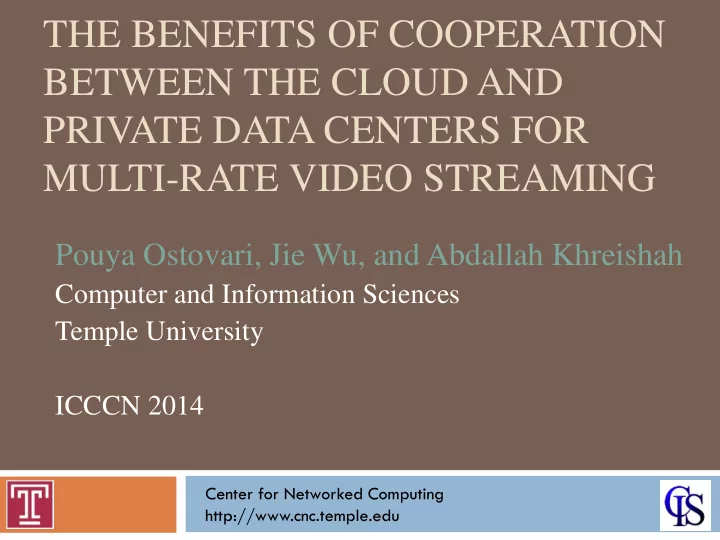

THE BENEFITS OF COOPERATION BETWEEN THE CLOUD AND PRIVATE DATA CENTERS FOR MULTI-RATE VIDEO STREAMING Pouya Ostovari, Jie Wu, and Abdallah Khreishah Computer and Information Sciences Temple University ICCCN 2014 Center for Networked Computing http://www.cnc.temple.edu
Agenda 2 Introduction Motivation Problem statement Cooperative video streaming Single-layer video streaming Multi-layer video streaming Conclusions
Motivation 3 Advances in technology Smartphones and tablets Internet is accessible everywhere Video streaming is used widely and frequently Video streaming is a dominant form of traffic on the Internet YouTube and Netflix: Produce 20-30% of the web traffic on the Internet High energy consumption
Motivation 4 Green computing Limited fossil fuels resources Global warming Reducing energy consumption is more important in the case that data centers use renewable energy The cost of servers change over time Depends on availability of renewable energy resources Reduce workload on servers, especially when the energy cost increases
System Model 5 A set of video servers (data centers) Geographically distributed all over the world Energy cost: storage and bandwidth Use renewable energy as their primary source of energy Renewable energy sources may not be available Or may not be available in the right quantity Using other power sources Increase the cost
System Model 6 Several user regions Costs and requests Expected number of requests from each region for a video Expected storage and bandwidth costs Objective Minimizing the cost of providing videos to the users
System Model 7 Solution: Using proxies (cloud) when the cost of the servers increases Estimating the cost based on the available predictions The amount of requests for the videos The cost of the servers Cost of the cloud service Transferring the popular videos to the cloud when the server cost is high Providing the streaming through the cloud
How to distribute the videos? 8 Storing videos Storing the videos in full on the cloud or in part? How to store the videos in part? Network coding can help Provides a fluid data model
Network Coding in Wired Networks 9 Single multicast session Bottleneck problem ( Ahlswede’00 ) No coding Coding
Video Coding Scheme 10 Partitioning the video Performing random linear network coding Coefficients are not shown for simplicity Storing the video in part f portion of each segment
Optimization 11 Linear programming Storage cost Storage cost Download cost Download cost Unit transmission cost Rate of movie m Transmission rate of movie m from cloud j to region i
Optimization 12 Unit transmission cost Rate of movie m Size of movie Transmission rate of Transmission rate of movie m from server movie m from server k to region i k to cloud j Unit storage cost Fraction of stored movie on cloud j
Optimization 13 Transmission rate of movie Size of movie m from server k to region i Unit transmission cost Expected requests for movie m from region i Fraction of stored movie m on Amount of download of movie m cloud j at time t from server k to cloud j
Optimization 14 Fraction of movie m on cloud j Rate of movie m Expected requests for movie m from region i Transmission rate of Transmission rate of movie m from server movie m from cloud j k to region i to region i
Multi-Layer Video 15 Delivering video stream using different resolutions to satisfy different client needs/constraints Multi-layer video (Multi-resolution) Example: H.264/SVC (scalable video coding) Base layer Enhancement layers
Multi-Resolution Video Streaming 16 Partitioning the video Random linear network coding Optimization The proposed linear programming can be modified to the case of multi-layer videos For each layer we have separate variables The constraints are generalized to the case of multiple layers
Simulation Setting 17 We developed a simulator in the MATLAB environment We compare our method with the case of streaming without cloud 100 runs for each setting Random costs, video sizes, video rates, and expected requests
Simulation Results 18 Single-Layer Video Streaming Fixed storage cost Fixed bandwidth cost
Simulation Results 19 Single-Layer Video Streaming Performance: cost without cloud/cost with cloud
Simulation Results 20 Multi-Resolution Video Streaming Fixed bandwidth cost
Conclusion 21 Increasing data traffic Video streaming is a dominant form of Internet traffic Increase in energy cost Using renewable energy as the primary source Using the help of clouds to reduce energy cost Optimal solution using linear programming Extension to the case of multi-layer videos
22 Questions? Pouya Ostovari: ostovari@temple.edu
Recommend
More recommend